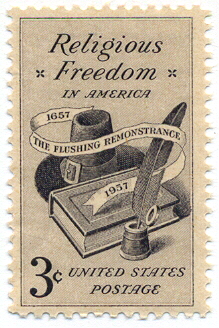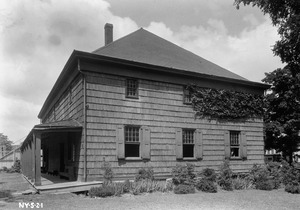Flushing Remonstrance facts for kids
The Flushing Remonstrance was an important letter written in 1657. It was sent to Peter Stuyvesant, who was the leader of the Dutch colony called New Netherland. About 30 people living in a small town called Flushing wrote this letter. They asked Stuyvesant to allow Quakers to worship freely, even though he had banned their meetings.
Many people see the Flushing Remonstrance as an early step towards freedom of religion in the United States. This idea later became a key part of the Bill of Rights in the U.S. Constitution.
According to historian Kenneth T. Jackson, the Flushing Remonstrance was special for three main reasons:
- It clearly stated a basic right that is very important to American freedom.
- The people who wrote it were brave. They sent it to a leader who was not known for being tolerant.
- They stood up for others, even though it didn't directly benefit them.
Contents
Why the Remonstrance Was Written
The village of Flushing, now in Queens, New York, was once part of the Dutch colony of New Netherland. English settlers first came to Flushing in 1645. They were given a special agreement that promised them the same religious freedom found in Holland. At that time, Holland was one of the most tolerant countries in Europe.
However, Peter Stuyvesant, the colony's leader, changed things. In 1656, he made a rule that banned all religions except the Dutch Reformed Church. This was the official church of the Netherlands. Stuyvesant's decision went against the long history of religious tolerance that had developed in Holland.
Stuyvesant's new rule caused problems. It was similar to policies in the Netherlands that officially recognized the Dutch Reformed Church. But it also meant turning a blind eye to other religious practices. Stuyvesant also opposed the arrival of Jewish people in New Amsterdam.
Many English settlers in towns like Flushing, Jamaica, and Gravesend did not like Stuyvesant's policy. These were places where Quaker missionaries had been sent. Stuyvesant's actions led to many acts of religious unfairness and harassment.
For example, in 1656, William Wickenden, a Baptist minister, was arrested. He was jailed, fined, and sent away for baptizing Christians in Flushing. That same year, Robert Hodgson was arrested for preaching Quakerism. He was sentenced to two years of hard labor. In 1661, Henry Townsend (Norwich) and Samuel Spicer were fined for holding Quaker meetings. Townsend was also banished. Stuyvesant even sent soldiers to stay in the homes of people who disagreed with him until they agreed to follow his rules.
The Protest and Its Aftermath
The Flushing Remonstrance was signed on December 27, 1657. The people who signed it were Dutch citizens. They were upset by the unfair treatment of Quakers and Stuyvesant's religious rules. None of the signers were Quakers themselves.
The Remonstrance ended with a powerful message about love, peace, and liberty. It said that these ideas should extend to everyone, no matter their background or religion. It also stated that the signers could not "lay violent hands" on anyone who came to their town in peace. They felt bound by God's law and their town's original agreement to treat everyone well.
When Stuyvesant received the Remonstrance, he was not happy. He fired the local government and chose new leaders. Four of the signers were arrested. Two of them quickly changed their minds. But Edward Hart, who wrote the Remonstrance, and Tobias Feake, the sheriff, stood firm. They were put in prison and lived on bread and water for over a month.
After friends and family asked for Hart's release, he was let go but was banished from the colony. Feake stayed in prison longer. He eventually gave in and was pardoned after paying a fine and being banned from public office.
Stuyvesant claimed he was not stopping people's "freedom of conscience." He said he was only stopping them from worshipping outside of family prayer meetings. He even declared March 13, 1658, a "Day of Prayer" to ask for forgiveness for the "sin" of religious tolerance.
Later, John Bowne, another settler in Flushing, allowed Quakers to meet in his house. He was arrested in 1662 and brought before Stuyvesant. Bowne refused to give up his beliefs. He was banished to Holland, even though he was English and didn't speak Dutch.
After several months in Holland, Bowne appealed to the leaders of the Dutch West India Company. This company was in charge of the colony. After thinking about it for a month, the company agreed with Bowne. They sent a letter to Stuyvesant in 1663, telling him to stop all religious persecution in New Netherland. One year later, in 1664, the British took control of the colony.
The John Bowne House, built before 1662, is still standing today. The Quaker Meeting House in Flushing, built in 1694, is the oldest place of worship in New York State that has been used continuously.
Signers of the Remonstrance
The 30 people who signed the Flushing Remonstrance were:
|
|
|
Edward Hart signed first as the clerk. Several other signers made an "X" mark to show their agreement.
John Bowne's Story
John Bowne kept a journal where he wrote about the Flushing Remonstrance and what happened afterward. Bowne arrived in New Netherland in 1651. He started hosting Quaker meetings in his home, even though he didn't officially become a Quaker until 1659. He later became an important leader for Quakers in America and communicated with George Fox, who founded the Quaker movement.
Legacy of the Remonstrance
The original Flushing Remonstrance document has been lost. However, an official copy from 1657 still exists. This copy is old and damaged but mostly complete. It is rarely shown to the public.
In 2007, the Queens Borough President's Office celebrated the 350th anniversary of the Remonstrance. Descendants of the signers, John Bowne, and Peter Stuyvesant were invited. The original copy of the Remonstrance was brought from the State Archives in Albany for public display.
Today, several places in Flushing are named in honor of John Bowne. These include Bowne Park, John Bowne High School, and an elementary school. PS 21 in Flushing is named after Edward Hart, who wrote the Remonstrance.



